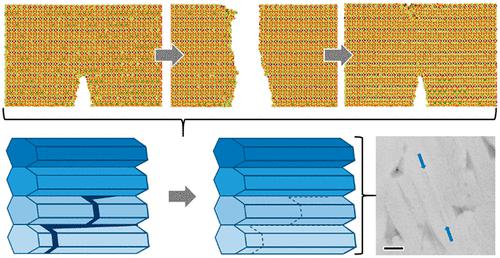Our official English website, www.x-mol.net, welcomes your
feedback! (Note: you will need to create a separate account there.)
Role of the Mineral in the Self-Healing of Cracks in Human Enamel
ACS Nano ( IF 15.8 ) Pub Date : 2022-06-24 , DOI: 10.1021/acsnano.1c10407 Andrew J Lew 1, 2 , Elia Beniash 3 , Pupa U P A Gilbert 4, 5, 6 , Markus J Buehler 1, 7
ACS Nano ( IF 15.8 ) Pub Date : 2022-06-24 , DOI: 10.1021/acsnano.1c10407 Andrew J Lew 1, 2 , Elia Beniash 3 , Pupa U P A Gilbert 4, 5, 6 , Markus J Buehler 1, 7
Affiliation

|
Human enamel is an incredibly resilient biological material, withstanding repeated daily stresses for decades. The mechanisms behind this resilience remain an open question, with recent studies demonstrating a crack-deflection mechanism contributing to enamel toughness and other studies detailing the roles of the organic matrix and remineralization. Here, we focus on the mineral and hypothesize that self-healing of cracks in enamel nanocrystals may be an additional mechanism acting to prevent catastrophic failure. To test this hypothesis, we used a molecular dynamics (MD) approach to compare the fracture behavior of hydroxyapatite (HAP) and calcite, the main minerals in human enamel and sea urchin teeth, respectively. We find that cracks heal under pressures typical of mastication by fusion of crystals in HAP but not in calcite, which is consistent with the resilience of HAP enamel that calcite teeth lack. Scanning transmission electron microscopy (STEM) images of structurally intact (“sound”) human enamel show dashed-line nanocracks that resemble and therefore might be the cracks healed by fusion of crystals produced in silico. The fast, self-healing mechanism shown here is common in soft materials and ceramics but has not been observed in single crystalline materials at room temperature. The crack self-healing in sound enamel nanocrystals, therefore, is unique in the human body and unique in materials science, with potential applications in designing bioinspired materials.
中文翻译:

矿物质在人类牙釉质裂缝自愈中的作用
人类牙釉质是一种非常有弹性的生物材料,可以承受数十年的反复日常压力。这种弹性背后的机制仍然是一个悬而未决的问题,最近的研究表明裂纹偏转机制有助于牙釉质韧性和其他研究详细说明有机基质和再矿化的作用。在这里,我们关注矿物并假设牙釉质纳米晶体中裂缝的自我修复可能是一种防止灾难性故障的额外机制。为了检验这一假设,我们使用分子动力学 (MD) 方法比较了羟基磷灰石 (HAP) 和方解石的断裂行为,这两种物质分别是人类牙釉质和海胆牙齿中的主要矿物质。我们发现裂纹在 HAP 而非方解石中通过晶体融合在咀嚼的典型压力下愈合,这与方解石牙齿所缺乏的 HAP 牙釉质的弹性是一致的。结构完好(“完好”)的人体牙釉质的扫描透射电子显微镜 (STEM) 图像显示虚线纳米裂纹,类似于裂纹,因此可能是由产生的晶体融合修复的裂纹在计算机中。此处显示的快速自愈机制在软材料和陶瓷中很常见,但在室温下尚未在单晶材料中观察到。因此,牙釉质纳米晶体中的裂纹自愈在人体中是独一无二的,在材料科学中也是独一无二的,在设计仿生材料方面具有潜在的应用价值。
更新日期:2022-06-24
中文翻译:

矿物质在人类牙釉质裂缝自愈中的作用
人类牙釉质是一种非常有弹性的生物材料,可以承受数十年的反复日常压力。这种弹性背后的机制仍然是一个悬而未决的问题,最近的研究表明裂纹偏转机制有助于牙釉质韧性和其他研究详细说明有机基质和再矿化的作用。在这里,我们关注矿物并假设牙釉质纳米晶体中裂缝的自我修复可能是一种防止灾难性故障的额外机制。为了检验这一假设,我们使用分子动力学 (MD) 方法比较了羟基磷灰石 (HAP) 和方解石的断裂行为,这两种物质分别是人类牙釉质和海胆牙齿中的主要矿物质。我们发现裂纹在 HAP 而非方解石中通过晶体融合在咀嚼的典型压力下愈合,这与方解石牙齿所缺乏的 HAP 牙釉质的弹性是一致的。结构完好(“完好”)的人体牙釉质的扫描透射电子显微镜 (STEM) 图像显示虚线纳米裂纹,类似于裂纹,因此可能是由产生的晶体融合修复的裂纹在计算机中。此处显示的快速自愈机制在软材料和陶瓷中很常见,但在室温下尚未在单晶材料中观察到。因此,牙釉质纳米晶体中的裂纹自愈在人体中是独一无二的,在材料科学中也是独一无二的,在设计仿生材料方面具有潜在的应用价值。











































 京公网安备 11010802027423号
京公网安备 11010802027423号